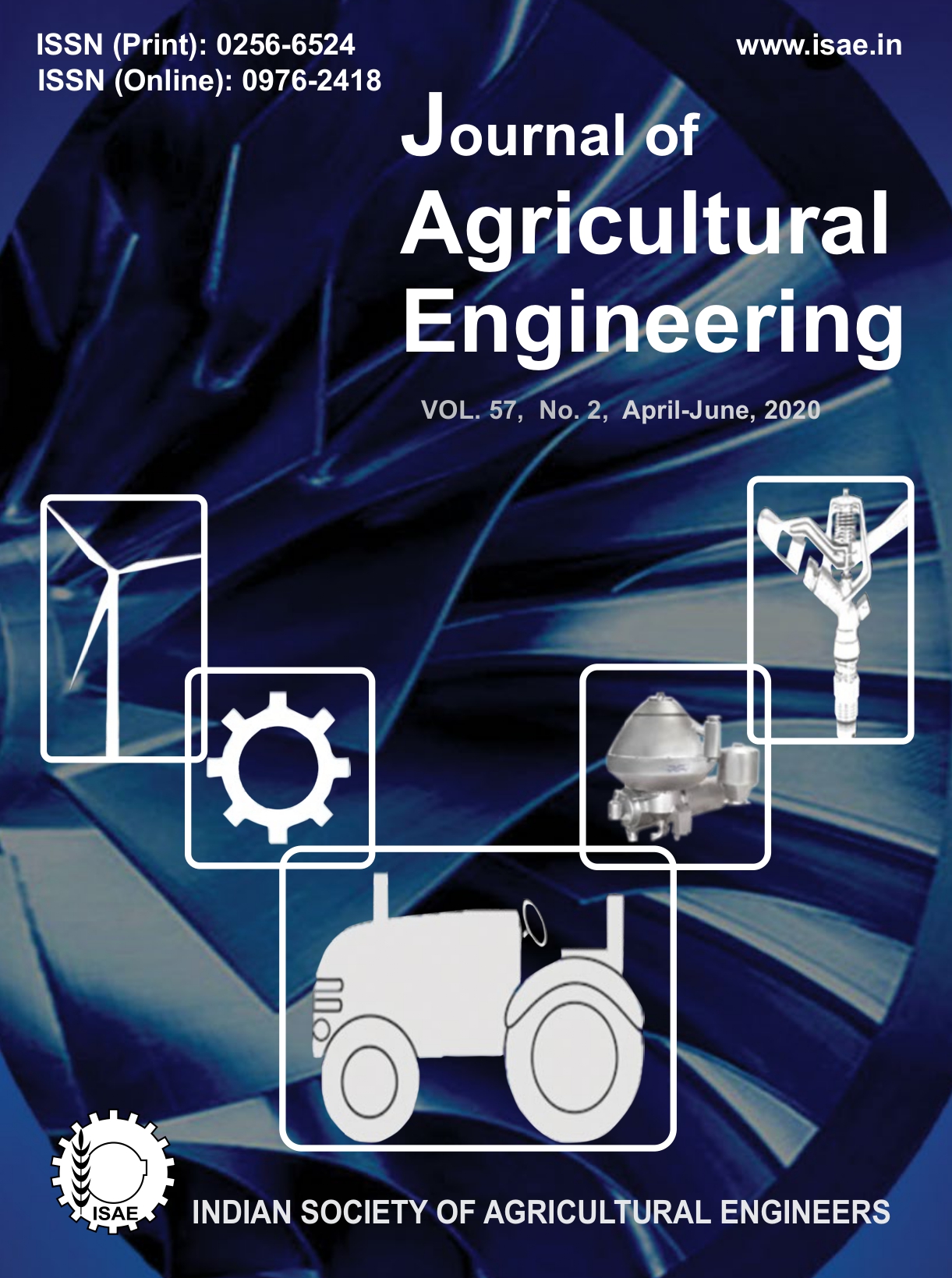Irrigation and Fertigation Management for Chilli (Capsicum annuum) under Drip Irrigation System
DOI:
https://doi.org/10.52151/jae2020572.1714Keywords:
Irrigation level, fertigation management, chilli crop, cost economicsAbstract
Water and nutrient are two key factors in improving production and quality of agricultural produce. Application of these two inputs through drip irrigation requires standardization of crop-specific water and fertilizer application levels in various agro-ecological regions. In order to develop better water and fertilizer management strategies in drip irrigated chilli, an experiment was conducted in split-plot design with 3 drip irrigation levels (I1 = 60 %, I2 = 80 %, I3 = 100 %) of full irrigation water requirement (IWR) in combination with 3 fertilizer levels (F1 = 80 %, F2 = 100 %, F3 = 120 %) of recommended dose of fertilizer (RDF). The treatment having water application at 80 % of IWR and 100 % of RDF (I2F2) showed significantly higher chilli yield (24.80 t.ha-1), water productivity (41.8 kg.ha-1. mm-1) and fertilizer use efficiency (55.1 kg.kg-1 of N). Results confirmed that excess use of water and fertilizer beyond threshold levels was not beneficial to plant growth and yield. The treatment I2 F2 showed highest net income (3,97,276 `. ha-1) and benefit-cost ratio (4.02), and is recommended for commercial cultivation of chilli in hot and humid regions as of Raipur, Chhattisgarh.
References
Abdul Hakkim V M. 2014. Effect of site-specific drip fertigation on yield of chilli. Int. Organ. Sci. Res. J. Eng., 4(1), 33-41.
Allen R G; Pereira L S; Raes D; Smith M. 1998. Crop Evapotranspiration —Guidelines for Computing Crop Water Requirements. FAO Irrigation and Drainage Paper 56, Food and Agriculture Organization, Rome, Italy, pp:15.
Anon. 2018. Horticultural Statistics at a Glance 2018. Horticulture Statistics Division, Department of Agriculture, Cooperation and Farmers’ Welfare, Ministry of Agriculture and Farmers’ Welfare, Government of India, New Delhi, pp: 458.
Anon. 2020. Chilli Outlook - May 2020. Agricultural Market Intelligence Centre, Professor Jayashankar Telangana State Agricultural University (PJTSAU), Rajendranagar, Hyderabad, India, pp: 3. (Available at: https://www.pjtsau.edu.in/files/AgriMkt/2020/may/ Chilli-may-2020.pdf, accessed on 14 June 2020)
Bhattarai M; Mariyono J. 2016.The economic aspects of chilli production in central Java. Econ. J. Emerging Markets, 8(2), 85-97.
Doorenbos J; Pruitt W. 1992. Crop Water Requirements. FAO Irrigation and Drainage Paper No. 24, Food and Agriculture Organization, Rome, Italy, 35-59.
Fanish S A; Muthukrishnan P; Santhi P. 2011. Effect of drip fertigation on field crops – A review. Agric. Rev., 32 (1),14 – 25.
Geetha R; Selvarani K. 2017. A study of chilli production and export from India. Int. J. Adv. Res. Innovative Ideas Educ., 2(3), 205-210.
Incrocci L; Massa D; Pardossi A. 2017. New trends in the fertigation management of irrigated vegetable crops. Hortic., 3, 3-37.
Megh R G; Panigrahi P. 2015. Sustainable Micro Irrigation Design Systems for Agricultural Crops. Apple Academic Press Inc., 160-162.
Nadiya N; Kurien E K; Mathew E K Varughese A. 2013. Impact of fertigation and drip system layout in performance of chilli (Capsicum annum). Int. J. Eng. Res. Dev., 7(9), 85-88.
Rana R; Ramesh; Kaushal S; Guleria G. 2014. Fertigation: A tool for efficient fertilizer and water management. Popular Kheti, 2(1), 37-44.
Reddy M; Ayyanagowdar M S; Patil M G; Polisgowdar B S; Nemichandrappa M; Anantachar M; Balanagoudar S R. 2017. Water use efficiency and economic feasibility of drip irrigation for watermelon (Citrullus lunatus). Int. J. Pure Appl. Biosci., 5 (3),1058-1064.
Singh A; Sharma S K; Chopra R; Singh V; Kaushik R A; Rathore R S; Jain H K. 2017. Impact of drip fertigation on yield and nutrients uptake by chilli (Capsicum annuum L.). Int. J. Curr. Microbiol. Appl. Sci., 6(8), 1409-1416.
Solaimalai A; Baskar M; Sadasakthi A; Subburamu K. 2005. Fertigation in high value crops – A review. Agric. Rev., 26(1),1-13.
Veeranna H K. 2000. Effect of fertigation, irrigation and potassium levels on the productivity of chilli (Capsicum annuum L.). Unpublished Ph.D. Thesis, University of Agricultural Sciences, Bangalore, 117-121.
Vijayakumar G; Tamilmani D; Selvaraj P K. 2010. Maximizing water and fertilizer use efficiencies under drip irrigation in chili crop. J. Manage. Public Policy, 2(1), 85-95.














